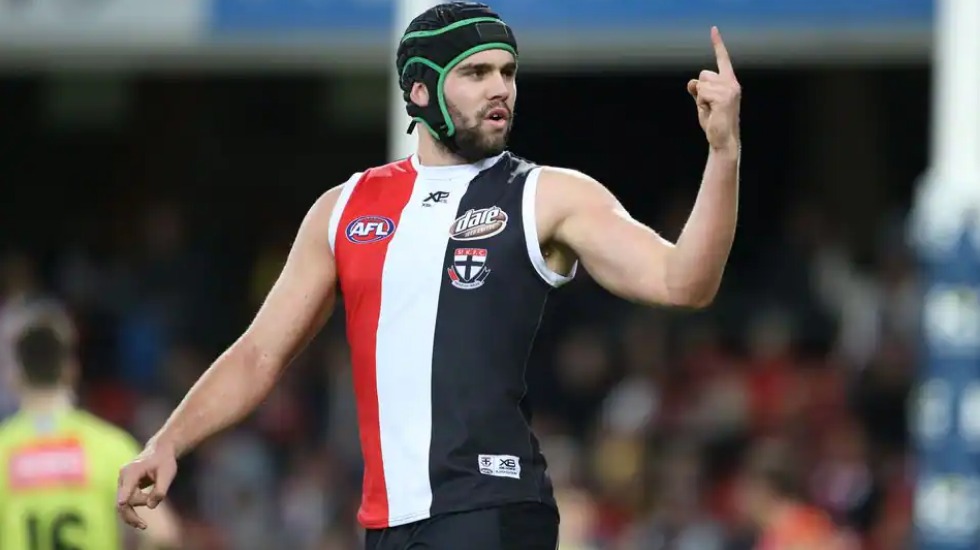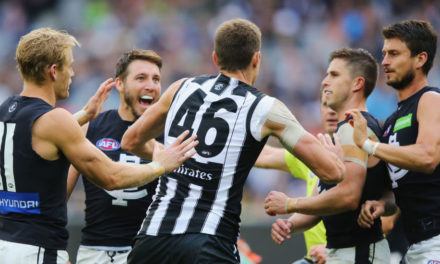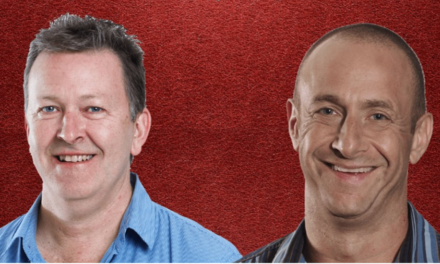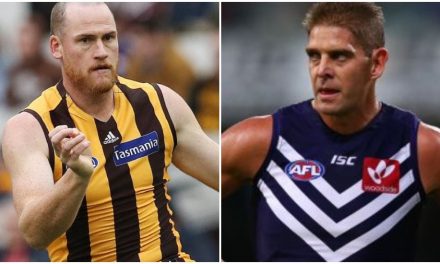Paddy McCartin was once the great hope for St Kilda, but a string of concussions cruelly cut his AFL career short. Photo: AFL MEDIA.
The final Coleman Medal standings in 2021 paint an interesting picture.
Harry McKay, at the age of 23, has become the youngest winner since Jack Riewoldt in 2010.
But looking through the other forwards that he beat out, some very familiar names appear: Tom Hawkins in second position; Riewoldt in third; Taylor Walker, Lance Franklin, and Charlie Dixon all feature prominently, too.
Ben King had an outstanding third season at the top level, and he represents an emerging younger class. But the fact remains that between McKay at 23, and the aforementioned stars who are all over 30, the only other tall to finish inside the top 10 was Josh Bruce at the age of 29.
Franklin, Hawkins and Riewoldt are champions of the game, so it’s no surprise to see them still performing so well. But realistically, shouldn’t they have been usurped by now? In contemporary footy, are we actually missing a cohort of key position forwards?
Less than a decade ago it looked like we were about to enter a golden age of high-quality, prodigiously-talented spearheads. High draft capital had been spent on this type of player. Both expansion clubs went hard at the top of their inaugural drafts to bring in star forwards, and these players were expected to slowly filter out across the competition.
Between the 2010 national draft – the first in which the Suns participated – and Harry McKay’s draft year in 2015, five gun junior forwards were chosen in the top three. If you add in Jesse Hogan, who was acquired by Melbourne in the 2012 mini-draft after trading pick three to GWS, it’s six top-three selections in six seasons. Remarkably, of those six, only three are still playing in the AFL. And of the other three, none kicked more than 20 goals in season 2021. How did this happen?
Sam Day was taken third overall by Gold Coast in 2010. He played 63 games in his first four seasons, but was quickly superseded by Tom Lynch and Charlie Dixon as the Suns’ main men up front. Battling injury and form in the years since, and also spending time down back, Day has not booted more than 19 goals in any season. He proved a useful guardian for King in all 17 matches last year, but after just six games this season and now out-of-contract, his future is unclear.
In 2011 and 2013, the Giants took Jon Patton and Tom Boyd with coveted number one selections.
Patton was one of footy’s hard luck stories, enduring two knee reconstructions without getting a proper run at it. He bounced back strongly in 2016 and 2017, tallying 83 goals across those seasons, before a third ACL in 2018 all but ended his time at the Giants. He played six games with Hawthorn in 2020, retiring in April this year after reports emerged linking him with allegations of inappropriate behaviour towards women. He was done at 27.
Still, he spent more time in the game than Boyd, who retired midway through 2019 at just 23. Boyd’s precocious talent was such that he was discussed as one of the best key position talents to ever come through the under 18 system. The 2016 premiership player, who was upfront about his mental health challenges throughout his career, will always be remembered fondly by Western Bulldogs people for his gargantuan, near-Norm-Smith-Medal-winning performance on that day.
Ultimately, he retired with 50 goals from 61 games, and clearly he went out on his own terms.
Hogan is an interesting one. He kicked 33 goals in 13 games as a 17-year-old in the VFL, and after overcoming a back injury that kept him out of his debut season, was a hype player heading into 2015 when he somehow managed to exceed expectations by kicking 44 goals and taking out the Rising Star award. A new hero of the competition was seemingly born.
PLEASE HELP US CONTINUE TO THRIVE BY BECOMING AN OFFICIAL FOOTYOLOGY PATRON. JUST CLICK THIS LINK.
Hogan’s story has been well told. After another good season in 2016, he experienced a sequence of wretched events, with the loss of his father due to cancer followed only weeks later by the announcement of his own diagnosis. Through all this, he copped an unwarranted level of criticism from the football public and punditry.
After an unsuccessful stint back home in Western Australia, Hogan now finds himself at GWS, where he averaged just under two goals a game this season. At 26, he still has time to reclaim his status as one of the competition’s stars.
Arguably the most troubling tale of this group is that of St Kilda’s 2014 number one draft selection, Paddy McCartin. Like Patton, McCartin simply never got a fair run, though his fortunes were determined due to repeated concussions.
Having suffered eight such incidents in the five years before he was reluctantly delisted at the end of 2019, McCartin was given the all-clear to continue playing, and has produced some good footy at centre-half back for Sydney’s VFL side. A return to AFL ranks is not out of the question.
Finally we get to McKay’s 2015 draft, with former Lion and current Bulldog Josh Schache selected at number two. Like others, Schache made a bright start, playing 17 matches in his first season and averaging a goal a game. Within a year, he’d become a fringe player at Brisbane, and was traded home to Victoria for two mid-range draft picks.
Whilst there have been question marks on Schache’s competitiveness, he remains a good mark and beautiful shot for goal, and has contributed strongly for the Bulldogs at both ends in recent weeks. Right now, he is the incumbent full-forward for a semi-finalist.
There are of course tall forwards who have filled the breach in this time. Jeremy Cameron, Joe Daniher, Lynch and Jack Darling all belong to this generation, and are all good players. However, only Cameron has been All-Australian on more than one occasion (twice, six years apart), none finished in the top 10 of the Coleman Medal this season, and all have had various issues with injury and/or form.
The man who kicked more goals than anyone between 2017-2019, Ben Brown, had to move clubs this season to continue his career. And whilst clearly a gun goalkicker, he has never been an All-Australian or Coleman Medallist.
Despite the broadly-accepted notion that you can only get quality key position players early in the draft, clubs appear to have become gun-shy in recent years. It’s always somewhat dependent on the strengths of the specific crop, but it is telling to note that between 2015 and 2018, not a single key forward was drafted inside the top 10, and few were taken later in the first round (Aaron Naughton, drafted at nine in 2017, was largely viewed as a defender at the time).
This changed, of course, in 2019 when Max and Ben King were taken at four and six respectively. Last year’s draft was also flush with talls at the top end, with likely types Jamarra Ugle-Hagan, Riley Thilthorpe, and Logan McDonald making up three of the first four selections.
Will this group, along with McKay and Naughton, fare better than the previous generation? None of this was overly predictable, and whilst early picks certainly face additional scrutiny, there’s nothing to suggest that these outcomes are anything other than a lamentable coincidence. A series of misfortunes, perhaps.
Footy fans can surely revel in putting this fluky class gap behind them, enjoying the twilight years of some all-time greats, and looking forward to what could be the golden age we had anticipated more than a decade ago.












Nice article